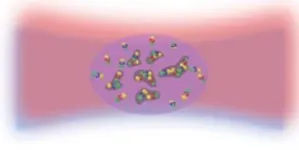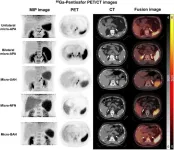(Press-News.org) Ever wonder what kind of TV shows your dog might choose if they could work the remote control? New research from the University of Wisconsin–Madison’s School of Veterinary Medicine provides some answers, but the study was more interested in solving a longstanding problem in veterinary medicine than turning canine companions into couch potatoes.
According to Freya Mowat, veterinary ophthalmologist and professor in the School of Veterinary Medicine’s department of surgical sciences, researchers wanted to determine factors, including age and vision, that influence a dog’s interest in interacting with video content. Ultimately, the goal of the study, which launched two years ago, was to support development of more sensitive ways to assess canine vision — something that has been sorely lacking in veterinary medicine.
“The method we currently use to assess vision in dogs is a very low bar. In humans, it would be equivalent to saying yes or no if a person was blind,” says Mowat. “We need more sensitive ways to assess vision in dogs, using a dog eye chart equivalent. We speculate that videos have the potential for sustaining a dog’s attention long enough to assess visual function, but we didn’t know what type of content is most engaging and appealing to dogs.”
Published recently in the journal Applied Animal Behaviour Science, the study found that dogs are most engaged when watching videos that feature other animals. Content featuring other dogs was the most popular. But if a National Geographic documentary about canine evolution seems too highbrow for your four-legged friend, Scooby Doo might be a perfectly acceptable option as well.
To better understand the type of content dogs might be most attracted to on screen, Mowat created a web-based questionnaire for dog owners around the globe to report the TV-watching habits of their canine companions.
Participants responded to questions about the types of screens in their homes, how their dogs interacted with screens, the kinds of content their dogs interacted with the most, as well as information about their dog’s age, sex, breed and where they live. They also provided descriptions of their dogs’ behavior when watching videos. Most commonly, dog owners described their pets’ behavior as active — including running, jumping, tracking action on screen and vocalizing — compared with passive behaviors like lying down or sitting. Dog owners also had the option to show their dog(s) four short videos featuring subjects of possible interest, including a panther, a dog, a bird and traffic moving along a road. They were then asked to rate their dog’s interest in each video and how closely the dog tracked the moving objects on the screen.
Mowat received 1,600 responses from dog owners across the world, including from the United States, Canada, the United Kingdom, the European Union and Australasia. Of those respondents, 1,246 ultimately completed the study. The following are some of the most interesting highlights:
Age and vision were related to how much a dog interacted with a screen.
Sporting and herding dog breeds appear to watch all content more than other breeds.
Video content featuring animals was the most popular, with other dogs being by far the most engaging subjects to watch.
Humans do not appear to be very appealing for dogs to watch, ranking ninth out of 17 predetermined categories.
Cartoons were engaging for more than 10% of dogs.
Movement on screens was a strong motivator for screen attention.
Mowat says she plans to build on the results of this study. Future research will focus on the development and optimization of video-based methods that can assess changes in visual attention as dogs age as well as answer questions that could help our four-legged friends age as gracefully as possible.
“We know that poor vision negatively impacts quality of life in older people, but the effect of aging and vision changes in dogs is largely unknown because we can’t accurately assess it,” she says. “Like people, dogs are living longer, and we want to make sure we support a healthier life for them as well.”
Another goal for Mowat is to compare how a dogs’ vision ages compared with the human or humans they share a home with.
“Dogs have a much shorter lifespan than their owner, of course, and if there are emerging environmental or lifestyle factors that influence visual aging, it might well show up in our dogs decades before it shows up in us,” she explains. “Our dogs could be our sentinels — the canine in the proverbial coal mine.”
This study was supported in part by an NIH career development grant to Mowat (K08EY028628), a Companion Animal Fund Grant from the UW–Madison School of Veterinary Medicine, a grant from Research to Prevent Blindness, Inc. to the UW–Madison Department of Ophthalmology and Visual Sciences and a core grant for Vision Research from the NIH to UW–Madison (P30 EY016665).
END
Knowing what dogs like to watch could help veterinarians assess their vision
Researchers at the University of Wisconsin–Madison have taken a novel approach to assessing canine vision. Their recent study uses a dog's interest in a variety of video content to better measure the quality of its vision.
2024-01-18
ELSE PRESS RELEASES FROM THIS DATE:
Household income and health insurance among factors in decision to withdraw life support after hemorrhagic stroke
2024-01-18
Living in a high-income neighborhood, having private health insurance, and being older are tied to an increased likelihood that life support will be withdrawn for people who have suffered severe bleeding in the brain, a new study shows.
Led by researchers at NYU Grossman School of Medicine, the study focused on the social and economic factors linked to the withdrawal of life support and related death after being hospitalized for intracerebral hemorrhages. Such bleeds, sometimes referred to as hemorrhagic stroke, often lead to swelling in the brain, which can put a patient into a coma and frequently ...
Xue lab at the CDI publishes groundbreaking insights into memory T cells in Nature Immunology
2024-01-18
The Xue Lab at the Hackensack Meridian Center for Discovery and Innovation (CDI) has made another breakthrough in better understanding, and potentially modulating, the immune system to fight diseases.
The insights into a specific protein and how it regulates the training and efficacy of central memory T cells are published by Hai-Hui (Howard) Xue, a member of the CDI, in the journal Nature Immunology.
The immunological implications could produce better vaccines and cancer treatments in the future, according to the Xue lab, which is also part of the Institute for Immunologic ...
Don’t look back: The aftermath of a distressing event is more memorable than the lead-up, study suggests
2024-01-18
Halfway through a true crime podcast, a morning commuter jerks the wheel to narrowly avoid a collision. When discussing the podcast with a coworker later that day, the driver can easily recall the details of the episode’s second half but retains only a blurry recollection of how it began.
A new study from psychologists at the Beckman Institute for Advanced Science and Technology suggests that we remember the moments immediately following a distressing episode more sharply than the moments leading up to it. Clarifying the relationship ...
FIFA World Cup ends with win for Argentina and COVID-19, new research finds
2024-01-18
TORONTO, Jan. 18, 2024 – The 2022 FIFA World Cup ended with a tight win for Argentina over France on penalties, but it was also a triumph for SARS-CoV-2 with a significant jump in the number of cases, some of which York University researchers say could have been prevented.
New research published today and led by York used the 2022 FIFA World Cup as a case study to help determine the best ways to mitigate virus spread and hospitalizations at mass gatherings in the future. A technique was used ...
New PET/CT technique accurately diagnoses adrenal gland disorder, informs personalized treatment plans
2024-01-18
Reston, VA—A novel imaging approach, 68Ga-pentixafor PET/CT, has been shown to accurately identify sub-types of primary aldosteronism (an adrenal gland disorder), outperforming traditional methods for diagnosis. Reported in the January issue of The Journal of Nuclear Medicine, this detailed imaging technique provides a clearer picture of the adrenal glands, helping doctors decide more confidently whether surgery is the right option for patients.
Primary aldosteronism is an endocrine disorder that occurs when the adrenal glands produce too much of the hormone aldosterone, frequently ...
A window into plant evolution: The unusual genetic journey of lycophytes
2024-01-18
An international team of researchers has uncovered a remarkable genetic phenomenon in lycophytes, which are similar to ferns and among the oldest land plants. Their study, recently published in the journal PNAS, reveals that these plants have maintained a consistent genetic structure for over 350 million years, a significant deviation from the norm in plant genetics.
"The exceptionally slow pace of genomic evolution sets these plants apart," said Dr. Fay-Wei Li, a professor at the Boyce Thompson Institute and a senior author of the study. ...
Climate change linked to spread of diarrheal illness
2024-01-18
Temperature, day length and humidity have been found to be linked to the increased spread of a diarrhoeal illness a new study from the University of Surrey reveals. The findings could help predict further outbreaks of the illness, potentially leading to better preparedness within health services.
During this unique study, researchers led by Dr Giovanni Lo Iacono, investigated the impact of weather on the transmission of campylobacteriosis, a bacterial infection which can cause diarrhoea and stomach pains. According to the World Health Organisation, Campylobacter infections are the most common causes of human bacterial gastroenteritis in the world. Infections are generally ...
Injectable agents could improve liquid biopsy for cancer detection and monitoring
2024-01-18
Scientists have developed two agents, made of therapeutic nanoparticles and antibodies, that could be given to patients shortly before a blood draw to allow physicians to better detect tumor DNA in blood using a technology called liquid biopsy.
Liquid biopsies promise to transform how cancers are diagnosed, monitored, and treated by detecting DNA that tumors shed into the blood. But the body presents a significant challenge. Immune cells in the liver and DNA-degrading enzymes in blood remove circulating tumor DNA from the bloodstream within minutes, making this DNA difficult to capture and detect in a blood test.
To overcome this, a team from the Broad Institute of MIT and Harvard ...
A fungal pathogen, Rosellinia necatrix, that attacks plants, produces antimicrobials to combat the plant-hosted bacteria that would otherwise inhibit its infection success
2024-01-18
A fungal pathogen, Rosellinia necatrix, that attacks plants, produces antimicrobials to combat the plant-hosted bacteria that would otherwise inhibit its infection success.
####
Article Title: The soil-borne white root rot pathogen Rosellinia necatrix expresses antimicrobial proteins during host colonization
Article URL: http://journals.plos.org/plospathogens/article?id=10.1371/journal.ppat.1011866
Author Countries: Germany, Spain, the Netherlands
Funding: EACC and DET acknowledge receipt of PhD fellowships from CONACyT, Mexico. ALM is holder of a postdoctoral research fellow funded by the 'Fundación Ramón Areces'. BPHJT ...
Researchers improve blood tests’ ability to detect and monitor cancer
2024-01-18
CAMBRIDGE, MA -- Tumors constantly shed DNA from dying cells, which briefly circulates in the patient’s bloodstream before it is quickly broken down. Many companies have created blood tests that can pick out this tumor DNA, potentially helping doctors diagnose or monitor cancer or choose a treatment.
The amount of tumor DNA circulating at any given time, however, is extremely small, so it has been challenging to develop tests sensitive enough to pick up that tiny signal. A team of researchers from MIT and the Broad Institute of MIT and Harvard has now come up with a way to significantly boost that signal, by temporarily slowing the clearance of tumor DNA circulating in the bloodstream.
The ...
LAST 30 PRESS RELEASES:
Numbers in our sights affect how we perceive space
SIMJ announces global collaborative book project in commemoration of its 75th anniversary
Air pollution exposure and birth weight
Obstructive sleep apnea risk and mental health conditions among older adults
How talking slows eye movements behind the wheel
The Ceramic Society of Japan’s Oxoate Ceramics Research Association launches new international book project
Heart-brain connection: international study reveals the role of the vagus nerve in keeping the heart young
Researchers identify Rb1 as a predictive biomarker for a new therapeutic strategy in some breast cancers
Survey reveals ethical gaps slowing AI adoption in pediatric surgery
Stimulant ADHD medications work differently than thought
AI overestimates how smart people are, according to HSE economists
HSE researchers create genome-wide map of quadruplexes
Scientists boost cell "powerhouses" to burn more calories
Automatic label checking: The missing step in making reliable medical AI
Low daily alcohol intake linked to 50% heightened mouth cancer risk in India
American Meteorological Society announces Rick Spinrad as 2026 President-Elect
Biomass-based carbon capture spotlighted in newly released global climate webinar recording
Illuminating invisible nano pollutants: advanced bioimaging tracks the full journey of emerging nanoscale contaminants in living systems
How does age affect recovery from spinal cord injury?
Novel AI tool offers prognosis for patients with head and neck cancer
Fathers’ microplastic exposure tied to their children’s metabolic problems
Research validates laboratory model for studying high-grade serous ovarian cancer
SIR 2026 delivers transformative breakthroughs in minimally invasive medicine to improve patient care
Stem Cell Reports most downloaded papers of 2025 highlight the breadth and impact of stem cell research
Oxford-led study estimates NHS spends around 3% of its primary and secondary care budget on the health impacts of heat and cold in England
A researcher’s long quest leads to a smart composite breakthrough
Urban wild bees act as “microbial sensors” of city health.
New study finds where you live affects recovery after a hip fracture
Forecasting the impact of fully automated vehicle adoption on US road traffic injuries
Alcohol-related hospitalizations from 2016 to 2022
[Press-News.org] Knowing what dogs like to watch could help veterinarians assess their visionResearchers at the University of Wisconsin–Madison have taken a novel approach to assessing canine vision. Their recent study uses a dog's interest in a variety of video content to better measure the quality of its vision.







